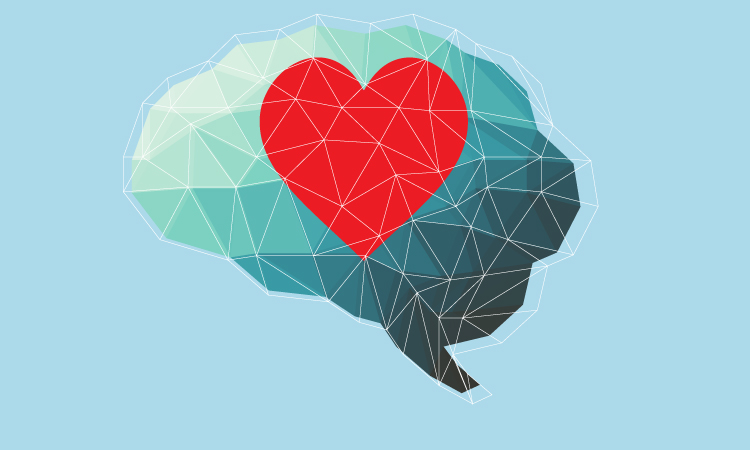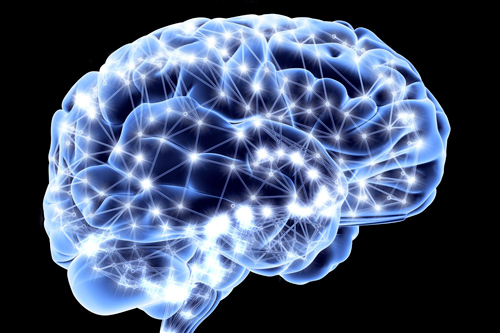Some of today’s most far-reaching findings in neuroscience are coming from the Institute of HeartMath (IHM), an organization that develops tools and technologies to help people self-regulate their emotions and behaviors. One visionary in this quest is Rollin McCraty, Ph.D., IHM’s executive vice president and director of research. Studies led by Dr. McCraty and his associates have greatly advanced our understanding of the interplay between the heart and the brain…and among the hearts of people worldwide.
Dr. McCraty’s path to IHM was hardly a straight line, but along the way he added several impressive achievements to his resume. After receiving advanced training in electrical systems engineering, he worked as a field engineer at Motorola. In 1989 he formed his own electrostatics company (studying the science of stationary electric charges), which he took from a start-up in a garage to a multimillion-dollar company within three years. A key part of this success story was his development of a new technology that revolutionized electrostatic problem solving. It’s still used by most technology companies today.

In a dramatic change of focus, Dr. McCraty then devoted his energies to a company that introduced the health benefits of spirulina to the Western world. After a front-page news story on spirulina appeared in the early 1980s, sales took off and he had a $20 million business. Dr. McCraty’s goal was to make spirulina a global food source to help feed the masses in countries with endemic malnutrition. He even built a demonstration showing how it could be grown in the middle of a desert, but politics kept getting in the way. “It popped my idealism bubble,” he recalls about this frustrating time. “I came to the deep understanding that the major problems facing our planet were going to require a huge shift in human consciousness.”
As his own consciousness was shifting, a fortuitous meeting opened the door to Dr. McCraty’s future of scientific breakthroughs. At a party he met Doc Childre, who had founded HeartMath in 1991, and there was an instant connection between the two. “Here’s something where I can actually affect people’s lives, help lift consciousness, and really make a difference,” he remembers thinking after first hearing about HeartMath.
The Heart Is Not Just a Metaphor for Positive Emotions
At IHM, Dr. McCraty and his associates have accumulated compelling evidence showing that the rhythms of the heart, defined as heart rate variability (HRV)—a term coined by IHM Scientific Advisory Board member Donald Singer, M.D.—do much more than keep blood in circulation. HRV tends to be erratic and disordered during times of stress, which results in transmission of signals from the heart to the brain that inhibit our ability to think clearly and make effective decisions. During positive emotional states, however, there is a smooth and harmonious pattern in heart rhythms (known as coherence).
Giving credence to these findings was the landmark work of Karl Pribram, M.D., considered by many to be the father of modern cognitive neuroscience. Dr. Pribram helped introduce the idea that the brain at a functional level is a system that recognizes and stores patterns of cognitive and emotional experiences. Since the heart is a primary source of rhythmic patterns in the body, claims Dr. Pribram, it is therefore a primary player in our emotional experience. “Solid theory from one of the top neuroscientists in the world shows that our heart is not just a metaphor in our emotional experience,” says Dr. McCraty. “The brain is interpreting the patterns in the heart, and we [at IHM] were showing that different emotions are reflected in different patterns in the heart rhythm.”
More support for this theory came from leading neurocardiologist J. Andrew Armour, M.D., Ph.D., whose articles in high-level academic publications stated that the heart basically has its own intrinsic brain. “We now know that the heart is sending more information to the brain than the other way around,” concurs Dr. McCraty.
Researchers at IHM have continued developing techniques for shifting erratic HRV patterns to more coherent ones that lead to a more positive emotional state. They have demonstrated clinically that coherent heart rhythms improve overall cognitive functioning, decision making, and emotional stability.
The Heart as “Switchboard” Connecting Us All
Ongoing IHM research on intuition and the heart may further elevate the heart’s status. “These studies show that the heart is responding to things even before the brain does,” says Dr. McCraty. The notion of heart intuition is not just an “out-there” theory; it is well supported by rigorous physiological data from a large analysis of 20 studies.
Yet even this “talent” of the heart may be only the tip of the iceberg. The theory that hearts can communicate with each other and combine forces is being given serious attention. “The heart is much more than just physical,” notes Dr. McCraty. “We also have the energetic heart. We’re suggesting that the energetic heart is the primary communications switchboard.” People may indeed be connected to each other in a way similar to how cellphones exchange signals.
This topic is of special interest to me due to an experience I had years ago when I felt a wave of anxiety at the exact moment (I would learn later) when my mother was having a stroke 2,500 miles away. Dr. McCraty explained it to me not as coincidence but as picking up a signal: “A lot of studies show that what we are attuned to is what we are emotionally bonded or connected to, what is emotionally relevant and important to us. This bonding tunes us to a particular frequency. We create resonant frequencies to pick out the waves.” In effect, this connection between people works like radio transmitters and wifi, and these signals are around us in space all the time. Due to my emotional connection, Dr. McCraty said, I may have been especially attuned to my mother’s signals.
Dr. McCraty adds that Earth’s own magnetic field might be aiding this transmission of signals between people. “The earth’s magnetic field is a carrier wave of biologically relevant information,” he says. “This is what connects us all. It’s also part of the intuition: how a mom knows her son or daughter is distressed on the other side of the planet. Something has to be conveying that information, which often seems to happen almost instantaneously. My hypothesis is that this is literally the magnetic field of the earth, and there is a fair amount of support on that.”
A Tidal Wave of Kindness
In the fall of 2013, the IHM launched the Global Coherence Initiative. The ambitious goals of this campaign are unprecedented: to quantify the impact of human emotion on the earth’s electromagnetic field and tip the global equation toward greater peace. While this may sound like a utopian fantasy, Dr. McCraty points out that science once again supports this possibility. “If the earth’s fields are a carrier, we are all coupled to this field, all the signals are out there,” he says. “So every emotion we experience is coupled to that field. This creates a global humanity field, if you will.” According to Dr. McCraty, this field is continually fed by our feelings, both positive and negative. The goal is to shift the balance toward the positive. “Any time we’re putting out love and kindness, that energy is not wasted,” he adds.
Current IHM research demonstrating the interconnectedness between people has Dr. McCraty very excited. Two studies going on in northern California and Saudi Arabia are monitoring HRV 24/7 to help quantify the interconnectivity between people and how it is affected by nervous system dynamics, the earth’s magnetic fields, solar flares, and even radio frequencies. Meanwhile, IHM continues helping people achieve coherence in their lives through training programs as well as products that facilitate self-regulation of emotions. It also has a program teaching preschoolers how to self-regulate that has improved both learning and motor skills.
Rollin McCraty and IHM may be providing one of our most important portals into a better future.
Bringing Hearts and Minds Together Across the Globe
Imagine a world where our hearts and minds are in a consistent state of synergy. Here’s an overview of how the Institute of HeartMath leads the way toward this harmony.
Click here to get inspired by Rose’s easy steps to positively change your mind




4 Comments
Ana
I want to express my gratitude posting here the translation to spanish… Thanks!!!!
Cerrando la brecha entre el corazón y el cerebro
https://www.rewireme.com/explorations/rollin-mccraty-closing-gap-heart-brain/#sthash.CRqQ5hNp.5LKfLvpA.dpbs
Rollin McCraty:
Cerrando la brecha entre el corazón y el cerebro
El Dr. McCraty y el Instituto de HeartMath están forjando un camino hacia un mayor bienestar para la humanidad en todo el mundo – vea más en: https://www.rewireme.com/explorations/rollin-mccraty-closing-gap-heart-brain/#sthash.CRqQ5hNp.5LKfLvpA.dpuf
Por Ed Decker – June 20, 2014
Algunos de los hallazgos más trascendentales de la actualidad en neurociencia están llegando desde el Instituto de HeartMath (IHM), una organización que desarrolla herramientas y tecnologías para ayudar a las personas a auto-regular sus emociones y comportamientos. Un visionario en esta búsqueda es Rollin McCraty, Ph.D., vicepresidente ejecutivo de IHM y el director de la investigación. Los estudios dirigidos por el Dr. McCraty y sus asociados han avanzado en gran medida nuestra comprensión de la interacción entre el corazón y el cerebro … y entre los corazones de la gente en todo el mundo.
La trayectoria del Dr. McCraty hacia el IHM era apenas una línea recta, pero en el camino, añadió varios logros impresionantes a su currículum. Después de recibir una formación avanzada en ingeniería de sistemas eléctricos, trabajó como ingeniero de campo en Motorola. En 1989 formó su propia compañía de la electrostática (el estudio de la ciencia de las cargas eléctricas estacionarias), que llevó de comenzar en un garaje hasta ser una empresa de varios millones de dólares en tres años. Una parte clave de este éxito fue su desarrollo de una nueva tecnología que revolucionó la solución de problemas de electrostática. Todavía es utilizado por la mayoría de las empresas de tecnología en la actualidad.
En un dramático cambio de foco, Dr. McCraty entonces dedicó sus energías a una empresa que presentó los beneficios de la espirulina para el mundo occidental. Después de una noticia de primera plana sobre la espirulina que apareció en la década de 1980, las ventas despegaron y tuvo un negocio de $20 millones. La meta del Dr. McCraty era hacer de la espirulina una fuente mundial de alimentos para ayudar a alimentar a las masas en los países con desnutrición endémica. Incluso construyó una demostración que muestra cómo se podría cultivar en medio de un desierto, pero las políticas se interponen. “Esto hizo estallar mi burbuja del idealismo”, recuerda de esta época frustrante. “Llegué a la comprensión profunda de que los principales problemas que enfrenta nuestro planeta van a requerir un gran cambio en la conciencia humana.”
A medida que su propia conciencia estaba cambiando, un encuentro fortuito abrió la puerta a un futuro de avances científicos del Dr. McCraty. En una fiesta conoció a Doc Childre, que había fundado HeartMath en 1991 y hubo una conexión inmediata entre los dos. “Aquí hay algo donde pueda afectar realmente a la vida de las personas, ayudar a levantar la conciencia, y realmente hacer la diferencia”, recuerda haber pensado después de la primera vez que escuchó sobre HeartMath.
El corazón no es sólo una metáfora para las emociones positivas
En IHM, Dr. McCraty y sus asociados han acumulado pruebas convincentes que muestran que los ritmos del corazón, que se definen como la variabilidad de la frecuencia cardiaca (HRV en Inglés) – un término acuñado por Donald Singer MD., miembro del Consejo Asesor Científico IHM, – hacen mucho más que mantener la sangre en circulación. La HRV tiende a ser errática y desordenada en momentos de estrés, lo que resulta en la transmisión de señales desde el corazón hasta el cerebro que inhiben nuestra capacidad de pensar con claridad y tomar decisiones eficaces. Durante los estados emocionales positivos, sin embargo, hay un patrón suave y armonioso en los ritmos cardíacos (conocido como coherencia).
Dar credibilidad a estos resultados fue el punto de referencia en el trabajo de Karl Pribram, MD, considerado por muchos como el padre de la neurociencia cognitiva moderna. El Dr. Pribram ayudó a introducir la idea de que el cerebro a nivel funcional es un sistema que reconoce y almacena patrones de experiencias cognitivas y emocionales. Puesto que el corazón es una fuente primaria de patrones rítmicos en el cuerpo, afirma el Dr. Pribram, por lo tanto, es un jugador principal en nuestra experiencia emocional. “Teoría sólida de uno de los mejores neurólogos del mundo muestra que nuestro corazón no es sólo una metáfora de nuestra experiencia emocional”, dice el Dr. McCraty. “El cerebro está interpretando los patrones del corazón, y nosotros [en IHM] estamos demostrando que diferentes emociones se reflejan en diferentes patrones en el ritmo del corazón.”
Más apoyo a esta teoría proviene del destacado neurocardiólogo J. Andrew Armour, MD, Ph.D., cuyos artículos en publicaciones académicas de alto nivel declararon que el corazón, básicamente, tiene su propio cerebro intrínseco. “Ahora sabemos que el corazón envía más información al cerebro que a la inversa”, coincide El Dr. McCraty.
Los investigadores de la IHM han seguido desarrollando técnicas para cambiar los patrones erráticos de HRV hacia otros más coherentes que conduzcan a un estado emocional más positivo. Han demostrado clínicamente que los ritmos cardíacos coherentes mejoran el funcionamiento general cognitivo, toma de decisiones, y la estabilidad emocional.
El corazón como el “Conmutador” Conectándonos con Todo
La Investigación vigente del IHM sobre la intuición y el corazón puede elevar aún más la posición jerárquica del corazón. “Estos estudios muestran que el corazón está respondiendo a las cosas incluso antes que el cerebro”, dice El Dr. McCraty. La noción de la intuición del corazón no es sólo una teoría de “allí afuera”; está bien soportada en la información fisiológica rigurosa de un extenso análisis de 20 estudios.
Sin embargo, incluso este “talento” del corazón puede ser sólo la punta del iceberg. A la teoría de que los corazones pueden comunicarse entre sí y combinar fuerzas se le está dando una atención seria. “El corazón es mucho más que físico”, señala el Dr. McCraty. “También tenemos el corazón energético. Estamos sugiriendo que el corazón energético es el conmutador principal de comunicaciones. “La gente puede de hecho estar conectada entre sí de una manera similar a cómo los celulares intercambian señales.
Este tema es de especial interés para mí debido a una experiencia que tuve hace años, cuando sentí una oleada de ansiedad en el momento exacto (que iba a descubrir más tarde) cuando mi madre estaba teniendo un derrame cerebral 2,500 millas de distancia. El Dr. McCraty me lo explicó no como coincidencia, sino como captar una señal: “Una gran cantidad de estudios muestran que con lo que estamos en sintonía es con lo que estamos en condiciones de vincularnos o conectamos emocionalmente, lo que es emocionalmente relevante e importante para nosotros. Esta unión nos sintoniza a una frecuencia particular. Creamos las frecuencias de resonancia para seleccionar las ondas. “En efecto, esta conexión entre la gente trabaja como transmisores de radio y wifi, y estas señales están a nuestro alrededor en el espacio todo el tiempo. Debido a la conexión emocional, El Dr. McCraty dijo, pude haber estado especialmente sintonizado con las señales de mi madre.
El Dr. McCraty añade que el propio campo magnético de la Tierra podría estar ayudando a la transmisión de señales entre las personas. “El campo magnético de la Tierra es una onda portadora de información biológicamente relevante,” dice. “Esto es lo que nos conecta a todos. Es también parte de la intuición: ¿cómo una madre sabe que su hijo o hija está en dificultades en el otro lado del planeta. Algo tiene que transmitir esa información, que a menudo parece suceder casi instantáneamente. Mi hipótesis es que esto es literalmente el campo magnético de la tierra, y hay una buena cantidad de ayuda en este. ”
Una Ola de Bondad
En el otoño de 2013, el IHM puso en marcha la Iniciativa de Coherencia Global. Los ambiciosos objetivos de esta campaña no tienen precedentes: cuantificar el impacto de las emociones humanas en el campo electromagnético de la tierra e inclinar la ecuación global hacia una mayor paz. Si bien esto puede sonar como una fantasía utópica, Dr. McCraty señala que la ciencia una vez más apoya esta posibilidad. “Si los campos de la tierra son un soporte, todos estamos acoplados a este campo, todas las señales están ahí fuera,” dice. “Así que cada emoción que experimentamos se acopla a ese campo. Esto crea un campo humano global, si se quiere “. Según el Dr. McCraty, este campo se alimenta continuamente de nuestros sentimientos, tanto positivos como negativos. El objetivo es cambiar la balanza hacia lo positivo. “Cada vez que estamos apagando el amor y la bondad, esta energía se desperdicia”, añade.
La investigación actual en IHM que demuestra la interrelación entre las personas tiene al Dr. McCraty muy emocionado. Dos estudios que tienen lugar en el norte de California y Arabia Saudita están monitoreando HRV 24/7 para ayudar a cuantificar la interconectividad entre las personas y la forma en que se ve afectada por la dinámica del sistema nervioso, los campos magnéticos de la tierra, las erupciones solares, e incluso las frecuencias de radio. Mientras tanto, IHM continúa ayudando a las personas a lograr la coherencia en sus vidas a través de programas de capacitación, así como productos que facilitan la auto-regulación de las emociones. También cuenta con un programa de enseñanza para niños en edad preescolar sobre cómo autorregularse que ha mejorado tanto el aprendizaje como las habilidades motoras.
Rollin McCraty y IHM pueden estar proporcionando uno de nuestros portales más importantes para un futuro mejor.
Poner Corazones y Mentes Juntos a través del Planeta – Ver más en:http://www.youtube.com/watch?v=QdneZ4fIIHE
Imagina un mundo en el que nuestros corazones y nuestras mentes están en un estado constante de sinergia. He aquí un resumen de cómo el Instituto de HeartMath lidera el camino hacia esa armonía. –
Más en: https://www.rewireme.com/explorations/rollin-mccraty-closing-gap-heart-brain/#sthash.CRqQ5hNp.5LKfLvpA.dpuf
Ed Decker
Thanks for the translation, Ana! Glad you enjoyed the article.
Roberto Arroyo
I came across with another science who started that he can bring about the person normal lower brain into a what he calls IT, The Higher Brain Living… With a sequence of sessions he touches the patient in time sequences and the patient describes a propelled urgent energy that completes the patient to move into a wave like fashion… The benefits of this HBL therapy is here in LA. And he has his institute in Chicago IL. Anyone interested in this alternative give me a call (626)715-6397 or better send me a message ar*******@ho*****.com
Rose Caiola
It’s incredible how our heart radiates energy in a way that impacts those around us. If we could all learn how to access our heart’s intelligence, it would make us better communicators and change the world we live in.